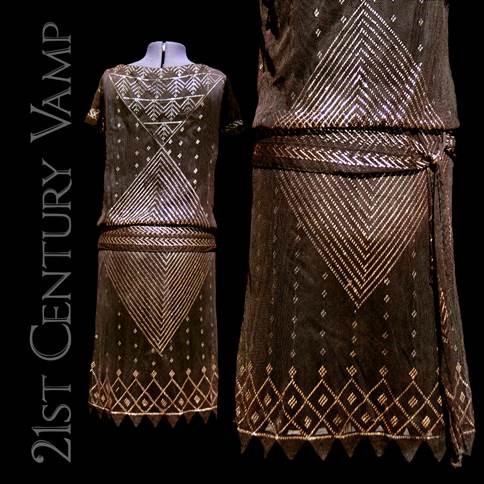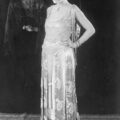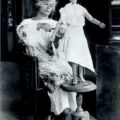1922 womens fashion
June 22, 2016In 1922 King Tutankhamen’s tomb was discovered. Due to various expeditions and explorations in Egypt, Britain was already having a little romance with Ancient Egypt, but this splendid find out in the desert whirled fascinated people into a passionate affair with Egyptomania that would last about five years, and 1922 womens fashion revelled in the details.
1922 womens fashion – a quick history of Egyptomania
There is something about the mystery of Ancient Egypt that has people hooked. A quick search for the term on Amazon gives us 70,368 books on the subject, and it’s not a new thing: in 450 BC – that’s two-and-a-half thousand years ago – the Greek writer and historian Herodotus visited Egypt, where the pyramids and sphinx at Giza were to be seen, edifices which were already two thousand years old in Herodotus’s day. He, very excited by his trip, enthused that “nowhere are there so many marvels in the world,” and that Egyptians have “existed ever since men existed upon the earth.”
Egyptian tourism before 1922 womens fashion
Herodotus was lucky to be an early Egyptian tourist. Not many Europeans knew much about Egypt until Napoleon set out to both capture modern Egypt and “discover” Ancient Egypt in 1798. The former failed miserably, but for the later he had brought a small army of scientists, scholars, artist and engineers to study the present and past culture of Egypt.
They looked at everything – local trade and industry, native plants and animals, minerals and soil, and the ground was mapped out using the latest modern methods. They also turned their attention to the strange native religion, and uncovered the temples and tombs of Luxor, Philae, Dendera, and the Valley of the Kings. Drawings and observations were made in abundance, and when they returned to France in 1801 these were organised into the smash hit book series, Description de l’Égypte, the first volume of which was published in 1809. Move over Harry Potter: by 1828, 23 volumes had appeared, each eagerly awaited. Three of them were published in a special edition of over a metre tall, the better to see the detailed engravings. Description de l’Égypte allowed armchair travellers the chance to bury themselves in the ancient artefacts of the Nile: the great carved obelisks, colossi, temples, and sphinxes, all mixed in with the daily flora and fauna of this far away land: the crocodiles, asps, lotuses, and palms enthralled and delighted its readers.
Egyptian travel books
In the 1840s the readers of Description de l’Égypte, (if they were rich) found they could finally visit the charms of Egypt themselves without a great amount of trouble with the advent of steamship tours. They might have liked the idea of great journeys over land and sea via sailing ship, horseback, camel and tiny, romantic felucca boats, but they were unlikely to undertake a journey like that from Europe without a year or two and a lot of money to spare for the adventure. Steamships cut the travel time considerably and were a reliable way to visit the wonders of the ancient world, without having to get too committed to learning Arabic and having close dealings with actual living Egyptians.
These excited visitors commenced to write a flood of new travel books, so those at home who couldn’t afford the journey could follow theirs.
Egyptian discoveries leading up to 1922 womens fashion
All this time, Egyptologists had been enthusiastically scraping away, uncovering and recording more tombs and artefacts, and in many cases taking them away to their own countries. Charities like the London-based Egypt Exploration Fund were set up to further the careers of archaeologists like Howard Carter, who diligently “discovered” the Tombs of Thutmose I and Thutmose III, although the fact that they had long ago been robbed of their treasures indicates that the locals already knew about them.
Carter was officially praised for his methods of protecting archaeological sites from damage during digs, because previously the sites were basically ransacked with little regard for conservation for the future. In fact many of the sites which had been preserved underground for thousands of years began to quickly deteriorate when they were dragged into the sunshine by the enthusiastic attention of their admirers. Until relatively recently anyone could climb the pyramids of Giza, and were allowed to carve their names triumphantly at the top.
Anyway, Howard Carter’s greatest discovery was the un-marred tomb of King Tutankhamen, complete with all its treasures. This occurrence in 1922 fuelled a huge new wave of Egyptomania.
1922 womens fashion – Egyptomania
1920s fashion women Art Deco style
Not that all this information lead to an accurate representation of the glories of the Nile. Ancient Egyptian motifs became a big part of Art Deco style overall, along with Chinese and Mayan designs. Huge, pompous tombs were built-in the Egyptian style across the Western world, some with Egyptian Sphinx guarding their entrances. But the Sphinx were pictured with little breasts, which would be right if they happened to be Greek, but not for Sphinx of this region.
Some ornaments featured Egyptianesque “Hieroglyphics” on, which were often little more than squiggles and didn’t spell out any particular sentence, although the Rosetta Stone, which enabled translations to be made between several languages, was discovered in 1799 so the real Egyptian hieroglyphs were well understood. The code for skin colour on tomb paintings, with yellow skin for females and red for males, brown for those foreign to Egypt, was also played fast and loose with.
As were the “Egyptian” outfits. In 1917 Theda Bara starred as Cleopatra in the most wonderful (historically incorrect) costumes and makeup. She had some great diaphanous wraps, tiny boob covers, and vaguely Egyptian motifs like embroidered asps on her garments, along with striped gold and blue head-gear.
1922 womens fashion – eyeliner and bobbed hair
1922 womens fashion already inclined to the heavily kohl lined eye, bobbed hair and knee-length skirts. Probably among other influences the breathless reporting of discoveries in Egyptian tombs of the clothes and modes of famous ancient beauties like Cleopatra influenced fashion, but the American press of 1922 had it the other way around, commenting on the apparently surprising similarities between Ancient Egypt and the Modern Girl – Ancient Egyptian ladies bobbed their hair, Ancient Egyptian ladies wore a lot of makeup,
Ancient Egyptian ladies wore short skirts and Ancient Egyptian ladies even had lovely decorated makeup compacts to shamelessly perform touch-ups in public. The mood of these articles was approving – these beauties had lived thousands of years ago in a highly civilised society and moreover were royalty, universally approved of – nay, admired – in accounts of the time. If it was OK for such illustrious predecessors to do that kind of thing, surely it was OK for the young women following 1922 womens fashion to do it too.
The amount of treasure discovered within the tombs was also a cause of astonishment. I wish they had left it there. In fact, I wish that they had never one searching so assiduously for the tombs in the first place, and could be content with the idea that something wonderful could well be beneath the ground they walked on, and perhaps left it at that. Or if they had to breach the tombs, perhaps a few drawings and photographs would have done. At least now a lot of the mummies and grave goods are being repatriated, although as far as I know they are not going back into the tombs they came from.
1922 womens fashion – bling
In any case, the amount of bling really dazzled people, and it wasn’t just the objects actually made of solid gold that got people but the decorations in gold leaf and the fact that according to the decorations on sarcophagi and various paintings and the garments that King Tut was wearing in his mummy case, Ancient Egyptians were really big on gold lamé and sequins. The king was dressed in a garment covered in thin gold discs which were stitched on like our sequins. The purpose here was probably more in the idea of carrying lots of gold on his person for the afterlife than to look fancy. Stitching coins or precious metal discs to clothes has been used as a way to safely carry wealth in many cultures. But then again, the Ancient Egyptians did like decoration and looking bling so perhaps it was a bit of both.
Sequins
Whichever, the flappers who set the height of 1922 womens fashion liked the look and dresses spangled with hundreds of sequins began to appear. But these sequins were made out of metal, so were heavy, unlike today’s lightweight plastic versions. They also tended to tarnish quite quickly, so when you see original 1922 womens fashion flapper dresses today, they look a bit dull so you have to work on imagining the original brilliant effect. At the same time, the Egyptian cloth of gold and gold leaf ushered in a fashion for gold lamé too. The simple tubular dresses that were the height of 1922 womens fashion were an ideal canvas for bold designs, giving plenty of surface on the front and back for Egyptian style designs. The sequins were sewn onto the short skirts or fashioned into long streamers to form the skirt, sometimes with an underskirt, sometimes without, to form the classic flapper look of 1922 womens fashion.
Scarab jewellery.
A sultry 1920s star in Egyptiana.
Ibis motif dress
Art Deco Egyptian lame dress
Egyptian inspired flapper dress.
Theda Bara as Cleopatra 1917
Theda Bara as Cleopatra 1917.
Palmolive ad 1920s









